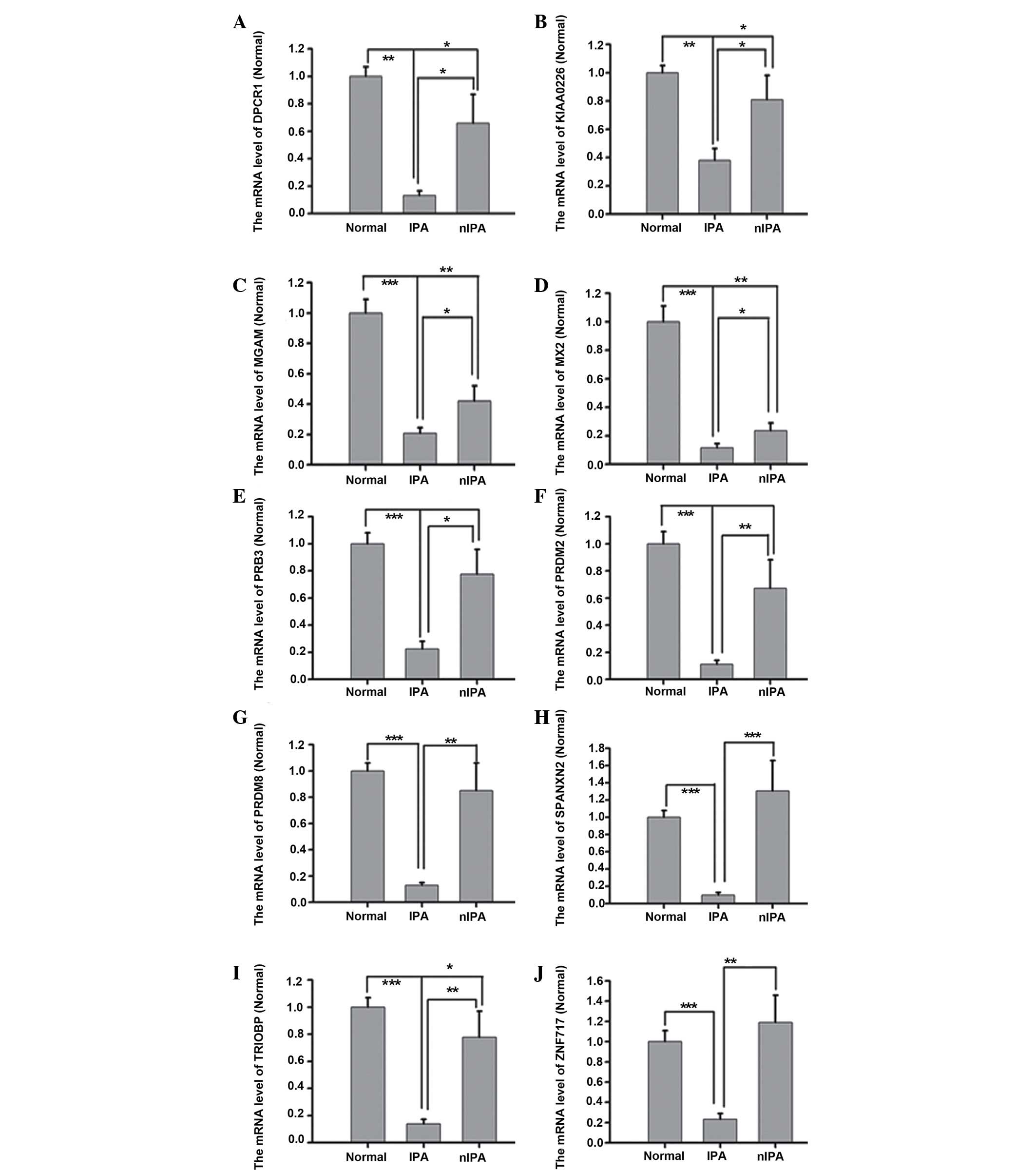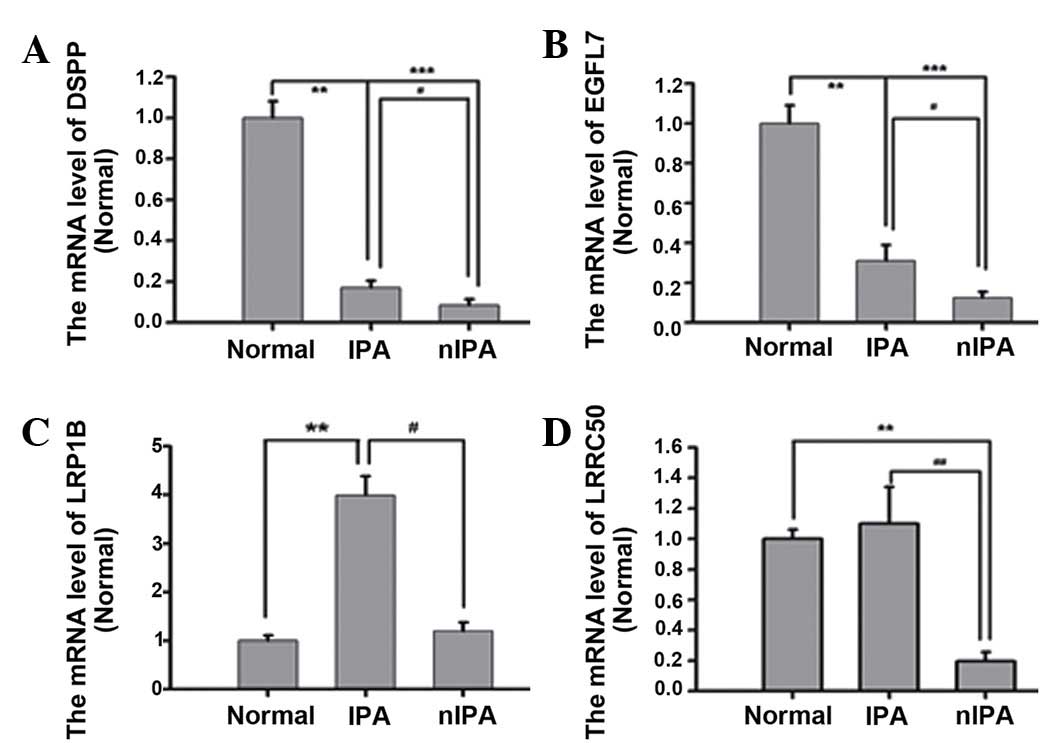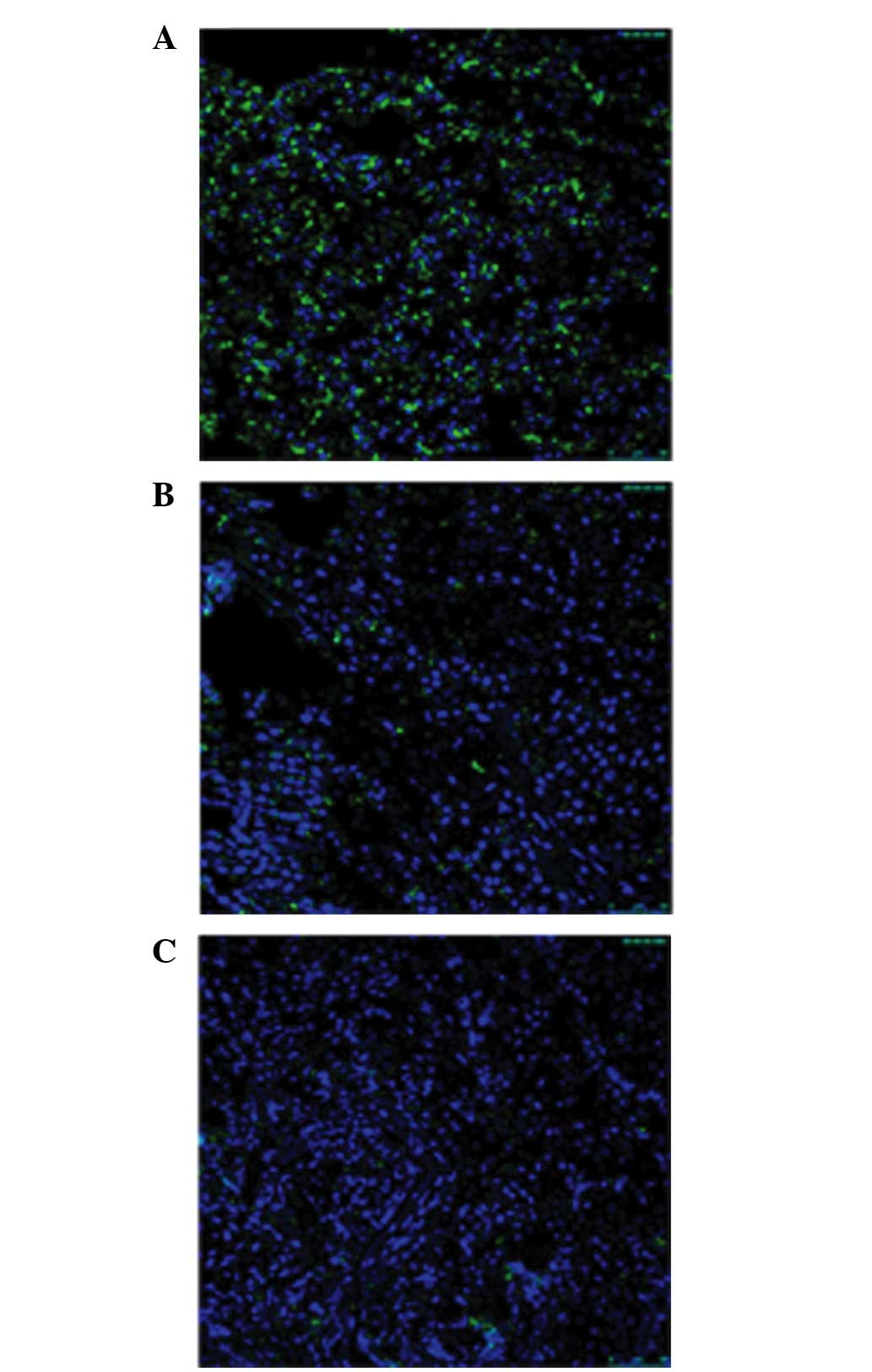|
1
|
Ezzat S, Asa SL, Couldwell WT, Barr CE,
Dodge WE, Vance ML and McCutcheon IE: The prevalence of pituitary
adenomas: A systematic review. Cancer. 101:613–619. 2004.
View Article : Google Scholar : PubMed/NCBI
|
|
2
|
Bronstein MD and Melmed S: Pituitary
tumorigenesis. Arq Bras Endocrinol Metabol. 49:615–625. 2005.(In
Portuguese). View Article : Google Scholar : PubMed/NCBI
|
|
3
|
Al-Shraim M and Asa SL: The 2004 World
Health Organization classification of pituitary tumors: What is
new? Acta Neuropathol. 111:1–7. 2006. View Article : Google Scholar : PubMed/NCBI
|
|
4
|
Scheithauer BW, Kovacs KT, Laws ER Jr and
Randall RV: Pathology of invasive pituitary tumors with special
reference to functional classification. Journal Neurosur.
65:733–744. 1986. View Article : Google Scholar
|
|
5
|
Colao A, Grasso LF, Pivonello R and
Lombardi G: Therapy of aggressive pituitary tumors. Expert Opin
Pharmacother. 12:1561–1570. 2011. View Article : Google Scholar : PubMed/NCBI
|
|
6
|
Di Ieva A, Rotondo F, Syro LV, Cusimano MD
and Kovacs K: Aggressive pituitary adenomas-diagnosis and emerging
treatments. Nat Rev Endocrinol. 10:423–435. 2014. View Article : Google Scholar : PubMed/NCBI
|
|
7
|
Lloyd RV, Kovacs K, Young WF Jr, Farrell
WE, Asa SL, Trouillas J, Kontogeorgos G, Sano T, Scheithauer BW and
Horvath E: Tumors of the pituitaryDeLellis RA, Lloyd RV, Heitz PU
and Eng C: World Health Organization Classification of Tumors:
Pathology and Genetics: Tumors of Endocrine Organs. IARC Press;
Lyon: pp. 10–47. 2004
|
|
8
|
Gejman R, Swearingen B and Hedley-Whyte
ET: Role of Ki-67 proliferation index and p53expression in
predicting progression of pituitary adenomas. Hum Pathol.
39:758–766. 2008. View Article : Google Scholar : PubMed/NCBI
|
|
9
|
Zada G, Woodmansee WW, Ramkissoon S,
Amadio J, Nose V and Laws ER Jr: Atypical pituitary adenomas:
Incidence, clinical characteristics, and implications. J Neurosurg.
114:336–344. 2011. View Article : Google Scholar : PubMed/NCBI
|
|
10
|
Mete O, Ezzat S and Asa SL: Biomarkers of
aggressive pituitary adenomas. J Mol Endocrinol. 49:R69–R78. 2012.
View Article : Google Scholar : PubMed/NCBI
|
|
11
|
Melmed S: 2004 World Health Organization
classification of pituitary tumors: What is new? Acta Neuropathol.
111:78–79. 2006. View Article : Google Scholar : PubMed/NCBI
|
|
12
|
Righi A, Morandi L, Leonardi E, Farnedi A,
Marucci G, Sisto A, Frank G, Faustini-Fustini M, Zoli M, Mazzatenta
D, et al: Galectin-3 expression in pituitary adenomas as a marker
of aggressive behavior. Hum Pathol. 44:2400–2409. 2013. View Article : Google Scholar : PubMed/NCBI
|
|
13
|
Galland F, Lacroix L, Saulnier P, Dessen
P, Meduri G, Bernier M, Gaillard S, Guibourdenche J, Fournier T,
Evain-Brion D, et al: Differential gene expression profiles of
invasive and non-invasive non-functioning pituitary adenomas based
on microarray analysis. Endocr Relat Cancer. 17:361–371. 2010.
View Article : Google Scholar : PubMed/NCBI
|
|
14
|
Schvartzman JM, Sotillo R and Benezra R:
Mitotic chromosomal instability and cancer: Mouse modelling of the
human disease. Nat Rev Cancer. 10:102–115. 2010. View Article : Google Scholar : PubMed/NCBI
|
|
15
|
Pilarski R and Nagy R: Genetic testing by
cancer site: Endocrine system. Cancer J. 18:364–371. 2012.
View Article : Google Scholar : PubMed/NCBI
|
|
16
|
Newey PJ, Nesbit MA, Rimmer AJ, Head RA,
Gorvin CM, Attar M, Gregory L, Wass JA, Buck D, Karavitaki N, et
al: Whole-exome sequencing studies of nonfunctioning pituitary
adenomas. J Clin Endocrinol Metab. 98:E796–E800. 2013. View Article : Google Scholar : PubMed/NCBI
|
|
17
|
Asa SL and Ezzat S: The pathogenesis of
pituitary tumours. Nat Rev Cancer. 2:836–849. 2002. View Article : Google Scholar : PubMed/NCBI
|
|
18
|
Zhan X, Desiderio DM, Wang X, Zhan X, Guo
T, Li M, Peng F, Chen X, Yang H, Zhang P, et al: Identification of
the proteomic variations of invasive relative to non-invasive
nonfunctional pituitary adenomas. Electrophoresis. 35:2184–2194.
2014.PubMed/NCBI
|
|
19
|
Yoshida K, Sanada M, Shiraishi Y, Nowak D,
Nagata Y, Yamamoto R, Sato Y, Sato-Otsubo A, Kon A, Nagasaki M, et
al: Frequent pathway mutations of splicing machinery in
myelodysplasia. Nature. 478:64–69. 2011. View Article : Google Scholar : PubMed/NCBI
|
|
20
|
Agrawal N, Frederick MJ, Pickering CR,
Bettegowda C, Chang K, Li RJ, Fakhry C, Xie TX, Zhang J, Wang J, et
al: Exome sequencing of head and neck squamous cell carcinoma
reveals inactivating mutations in NOTCH1. Science. 333:1154–1157.
2011. View Article : Google Scholar : PubMed/NCBI
|
|
21
|
Ni X, Zhuo M, Su Z, Duan J, Gao Y, Wang Z,
Zong C, Bai H, Chapman AR, Zhao J, et al: Reproducible copy number
variation patterns among single circulating tumor cells of lung
cancer patients. Proc Natl Acad Sci USA. 110:21083–21088. 2013.
View Article : Google Scholar : PubMed/NCBI
|
|
22
|
Enseñat J, Ortega A, Topcewski T, Vilalta
J, Obiols G, Mesa J and Sahuquillo J: Predictive value of the Knosp
classification in grading the surgical resection of invasive
pituitary macroadenomas. A prospective study of 23 cases.
Neurocirugia (Astur). 17:519–26. 2006.(In Spanish). View Article : Google Scholar : PubMed/NCBI
|
|
23
|
Wang F, Gao H, Li C, Bai J, Lu R, Cao L,
Wu Y, Hong L, Wu Y, Lan X and Zhang Y: Low levels of PRB3 mRNA are
associated with dopamine-agonist resistance and tumor recurrence in
prolactinomas. J Neurooncol. 116:83–88. 2014. View Article : Google Scholar : PubMed/NCBI
|
|
24
|
Livak KJ and Schmittgen TD: Analysis of
relative gene expression data using real-time quantitative PCR and
the 2(−Delta Delta C(T)) Method. Methods. 25:402–408. 2001.
View Article : Google Scholar : PubMed/NCBI
|
|
25
|
Jiao Y, Shi C, Edil BH, de Wilde RF,
Klimstra DS, Maitra A, Schulick RD, Tang LH, Wolfgang CL, Choti MA,
et al: DAXX/TRX, MEN1, and mTOR pathway genes are frequently
altered in pancreatic neuroendocrine tumors. Science.
331:1199–1203. 2011. View Article : Google Scholar : PubMed/NCBI
|
|
26
|
Newey PJ, Nesbit MA, Rimmer AJ, Attar M,
Head RT, Christie PT, Gorvin CM, Stechman M, Gregory L, Mihai R, et
al: Whole-exome sequencing studies of nonhereditary (sporadic)
parathyroid adenomas. J Clin Endocrinol Metab. 97:E1995–E2005.
2012. View Article : Google Scholar : PubMed/NCBI
|
|
27
|
Barbieri CE, Baca SC, Lawrence MS,
Demichelis F, Blattner M, Theurillat JP, White TA, Stojanov P, Van
Allen E, Stransky N, et al: Exome sequencing identifies recurrent
SPOP, FOXA1 and MED12 mutations in prostate cancer. Nat Genet.
44:685–689. 2012. View
Article : Google Scholar : PubMed/NCBI
|
|
28
|
Popescu MN, Ionescu E, Iovănescu LC, Cotoi
BV, Popescu AI, Gănescu AE, Glodeanu A, Geormăneanu C, Moraru A and
Pătraşcu A: Clinical aggression of prolactinomas: Correlations with
invasion and recurrence. Rom J Morphol Embryol. 54:1075–1080.
2013.PubMed/NCBI
|
|
29
|
Varier RA and Timmers HT: Histone lysine
methylation and demethylation pathways in cancer. Biochimica
Biophysica Acta. 1815:75–89. 2011.
|
|
30
|
Tanase C, Ogrezeanu I and Badiu C:
Pituitary tumor classification: Functionality, invasiveness and
aggressivenessMolecular Pathology of Pituitary Adenomas. Elsevier;
Amsterdam, Netherlands: pp. 1–18. 2011
|
|
31
|
Dhodapkar MV: Personalized
immune-interception of cancer and the battle of two adaptive
systems-when is the time right? Cancer Prev Res (Phila). 6:173–176.
2013. View Article : Google Scholar : PubMed/NCBI
|
|
32
|
DuPage M, Cheung AF, Mazumdar C, Winslow
MM, Bronson R, Schmidt LM, Crowley D, Chen J and Jacks T:
Endogenous T cell responses to antigens expressed in lung
adenocarcinomas delay malignant tumor progression. Cancer Cell.
19:72–85. 2011. View Article : Google Scholar : PubMed/NCBI
|
|
33
|
Wang W, Xu Z, Fu L, Liu W and Li X:
Pathogenesis analysis of pituitary adenoma based on gene expression
profiling. Oncol Lett. 8:2423–2430. 2014.PubMed/NCBI
|
|
34
|
Shen FF, Yue WB, Zhou FY, Pan Y, Zhao XK,
Jin Y, Song X, Li B, Han XN, Tang S, et al: Variations in the MHC
region confer risk to esophageal squamous cell carcinoma on the
subjects from high-incidence area in northern China. PloS One.
9:e904382014. View Article : Google Scholar : PubMed/NCBI
|
|
35
|
Lee JS, Bae JS, Kim JH, Kim JY, Park TJ,
Pasaje CF, Park BL, Cheong HS, Uh ST, Park JS, et al: Effect of
diffuse panbronchiolitis critical region 1 polymorphisms on the
risk of aspirin-exacerbated respiratory disease in Korean
asthmatics. Respir Care. 57:758–763. 2012. View Article : Google Scholar : PubMed/NCBI
|
|
36
|
Osamura RY, Kajiya H, Takei M, Egashira N,
Tobita M, Takekoshi S and Teramoto A: Pathology of the human
pituitary adenomas. Histochem Cell Biol. 130:495–507. 2008.
View Article : Google Scholar : PubMed/NCBI
|
|
37
|
Schmidt M, Paes K, De Mazière A, Smyczek
T, Yang S, Gray A, French D, Kasman I, Klumperman J, Rice DS and Ye
W: EGFL7 regulates the collective migration of endothelial cells by
restricting their spatial distribution. Development. 134:2913–2923.
2007. View Article : Google Scholar : PubMed/NCBI
|
|
38
|
Schmidt MH, Bicker F, Nikolic I, Meister
J, Babuke T, Picuric S, Müller-Esterl W, Plate KH and Dikic I:
Epidermal growth factor-like domain 7 (EGFL7) modulates Notch
signalling and affects neural stem cell renewal. Nat Cell Biol.
11:873–880. 2009. View Article : Google Scholar : PubMed/NCBI
|
|
39
|
Bambino K, Lacko LA, Hajjar KA and
Stuhlmann H: Epidermal growth factor-like domain 7 is a marker of
the endothelial lineage and active angiogenesis. Genesis.
52:657–670. 2014. View Article : Google Scholar : PubMed/NCBI
|
|
40
|
Louvi A and Artavanis-Tsakonas S: Notch
signalling in vertebrate neural development. Nat Rev Neurosci.
7:93–102. 2006. View Article : Google Scholar : PubMed/NCBI
|
|
41
|
Jiang Z, Gui S and Zhang Y: Analysis of
differential gene expression in plurihormonal pituitary adenomas
using bead-based fiber-optic arrays. J Neurooncol. 108:341–348.
2012. View Article : Google Scholar : PubMed/NCBI
|
|
42
|
Lu R, Gao H, Wang H, Cao L, Bai J and
Zhang Y: Overexpression of the Notch3 receptor and its ligand
Jagged1 in human clinically non-functioning pituitary adenomas.
Oncol Lett. 5:845–851. 2013.PubMed/NCBI
|
|
43
|
Howard J and Hyman AA: Dynamics and
mechanics of the microtubule plus end. Nature. 422:753–758. 2003.
View Article : Google Scholar : PubMed/NCBI
|
|
44
|
Azorín E, Romero-Pérez B, Solano-Agama C,
de la Vega MT, Toriz CG, Reyes-Márquez B, González-Pozos S,
Rosales-García VH, Del Pliego MG, Sabanero M and Mendoza-Garrido
ME: GH3 tumor pituitary cell cytoskeleton and plasma membrane
arrangement are determined by extracellular matrix proteins:
Implications on motility, proliferation and hormone secretion. Int
J Physiol Pathophysiol Pharmacol. 6:66–83. 2014.PubMed/NCBI
|
|
45
|
delPliego MG, Aguirre-Benítez E,
Paisano-Cerón K, Valdovinos-Ramírez I, Rangel-Morales C,
Rodríguez-Mata V, Solano-Agama C, Martín-Tapia D, de la Vega MT,
Saldoval-Balanzario M, et al: Expression of Eag1 K+ channel and
ErbBs in human pituitary adenomas: Cytoskeleton arrangement
patterns in cultured cells. Int J Clin Exp Pathol. 6:458–468.
2013.PubMed/NCBI
|
|
46
|
Stolc V, Samanta MP, Tongprasit W and
Marshall WF: Genome-wide transcriptional analysis of flagellar
regeneration in Chlamydomonas reinhardtii identifies orthologs of
ciliary disease genes. Proc Natl Acad Sci USA. 102:3703–3707. 2005.
View Article : Google Scholar : PubMed/NCBI
|
|
47
|
Avidor-Reiss T, Maer AM, Koundakjian E,
Polyanovsky A, Keil T, Subramaniam S and Zuker CS: Decoding cilia
function: Defining specialized genes required for compartmentalized
cilia biogenesis. Cell. 117:527–539. 2004. View Article : Google Scholar : PubMed/NCBI
|
|
48
|
Van Rooijen E, Giles RH, Voest EE, van
Rooijen C, Schulte-Merker S and van Eeden FJ: LRRC50, a conserved
ciliary protein implicated in polycystic kidney disease. J Am Soc
Nephrol. 19:1128–1138. 2008. View Article : Google Scholar : PubMed/NCBI
|
|
49
|
Basten SG, Davis EE, Gillis AJ, van
Rooijen E, Stoop H, Babala N, Logister I, Heath ZG, Jonges TN,
Katsanis N, et al: Mutations in LRRC50 predispose zebrafish and
humans to seminomas. PLoS Genet. 9:e10033842013. View Article : Google Scholar : PubMed/NCBI
|
|
50
|
Hohenauer T and Moore AW: The Prdm family:
Expanding roles in stem cells and development. Development.
139:2267–2282. 2012. View Article : Google Scholar : PubMed/NCBI
|
|
51
|
Davis CA, Haberland M, Arnold MA,
Sutherland LB, McDonald OG, Richardson JA, Childs G, Harris S,
Owens GK and Olson EN: PRISM/PRDM6, a transcriptional repressor
that promotes the proliferative gene program in smooth muscle
cells. Mol Cell Biol. 26:2626–2636. 2006. View Article : Google Scholar : PubMed/NCBI
|
|
52
|
Kajimura S, Seale P, Tomaru T,
Erdjument-Bromage H, Cooper MP, Ruas JL, Chin S, Tempst P, Lazar MA
and Spiegelman BM: Regulation of the brown and white fat gene
programs through a PRDM16/CtBP transcriptional complex. Genes Dev.
22:1397–1409. 2008. View Article : Google Scholar : PubMed/NCBI
|
|
53
|
Izutsu K, Kurokawa M, Imai Y, Maki K,
Mitani K and Hirai H: The corepressor CtBP interacts with Evi-1 to
repress transforming growth factor beta signaling. Blood.
97:2815–2822. 2001. View Article : Google Scholar : PubMed/NCBI
|
|
54
|
Yu J, Angelin-Duclos C, Greenwood J, Liao
J and Calame K: Transcriptional repression by blimp-1 (PRDI-BF1)
involves recruitment of histone deacetylase. Mol Cell Biol.
20:2592–2603. 2000. View Article : Google Scholar : PubMed/NCBI
|
|
55
|
Tam W, Gomez M, Chadburn A, Lee JW, Chan
WC and Knowles DM: Mutational analysis of PRDM1 indicates a
tumor-suppressor role in diffuse large B-cell lymphomas. Blood.
107:4090–4100. 2006. View Article : Google Scholar : PubMed/NCBI
|

















